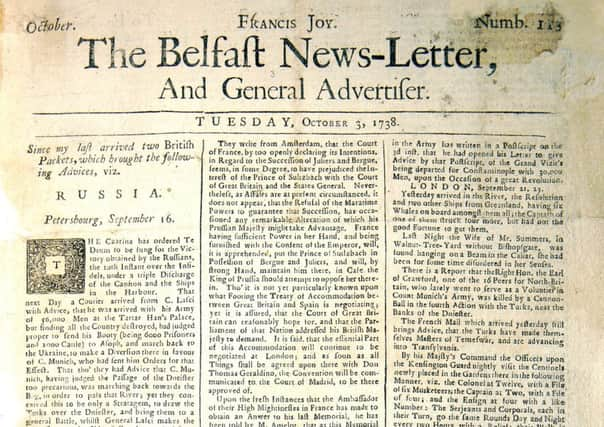The earliest copy of the Belfast News Letter, the world’s oldest daily newspaper, turns 280 today


The Belfast News Letter and General Advertiser (as it was called when it was launched in 1737) is the oldest continuously published of the daily titles printed in English, 50 years older than The Times (of London).
The paper itself reached its 280th birthday in September last year. But the first 13 months of the paper are lost, and the oldest surviving paper is in fact from October 3 1738, which is equivalent to October 14 in the modern calendar.
Advertisement
Hide AdAdvertisement
Hide AdIt is the earliest edition in an intact nine-month batch of News Letters from 1738 and 1739 that are held at the Linen Hall Library in central Belfast.
In the above picture, you can see the Duke and Duchess of Cornwall being shown the earliest News Letter on a visit to the library in 2009.
If Prince Charles becomes king, he will be the 11th monarch on whom the News Letter has reported since 1737 (his mother, Queen Elizabeth II, is the 10th).
Over those same 280 years, the News Letter has reported on 76 prime ministers.
Advertisement
Hide AdAdvertisement
Hide AdThe latest is Theresa May. The earliest papers from 1738 and 1739 have reports on Robert Walpole, who was Britain’s first premier, and also on Downing Street, which even then was the PM’s base.
Sadly the 1738-39 batch of News Letters are among the only surviving papers between 1737 and the early 1750s. Out of the first 1,500 or so News Letters from those first years, around 1,400 are lost.
That sample of surviving copies, including the October 3 1738 edition, give a fascinating glimpse into life in the north of Ireland (there was no such thing as Northern Ireland, and there would not be for almost 200 years) in the early to mid 1700s.
The early owners and readers of the News Letter could not have known that the missing editions would become so important because there were many emerging newspapers at the time in Europe and north America, and few of them lasted more than a few years.
Advertisement
Hide AdAdvertisement
Hide AdThere is a surviving edition of the News Letter dated March 1738 which is wrongly thought to be the oldest copy, but this is due to confusion over the old Julian calendar, in which the new year began at the end of March. In fact, the March 1738 edition is actually March 1739 in the modern Gregorian calendar.
The Julian calendar, which was replaced in 1752, went from December 31 1738 to January 1 1738 (rather than to January 1 1739). This is so hard for modern readers to grasp that the News Letter itself got confused as early as 1837 when, on its centenary, it wrongly reproduced the March 1738 edition as the oldest surviving paper, instead of the even older October 1738 edition.
• See Morning View
• Excerpts from 280 years ago, the October 3 1738 edition (Oct 14) of the Belfast News Letter:
HIGHWAY ROBBERY:
On Thursday last between the Hours of Four and Five in the Morning the Flying Bath Coach, was stopped by a single Foot-Pad, about Half a Mile on the Side of Newbury; there were five Passengers in the Coach; the Robber took from a Sardinian Gentleman a Purse of Guineas and a rich Scimitar;
Advertisement
Hide AdAdvertisement
Hide Adfrom Capt. Willoughby, of Abchurch-lane, one Pound and Six Shillings together with his Coat and Perriwig; from Mr Rawlinson, [missing]-Constable of Westminster, three Half-Crowns, together with his Perriwig and Silver [missing]-Buckle; and from Mr Pratt the Master and Driver of the Coach, four Guineas and his Silver Watch;
The Rogue behaved in a most insolent Manner to the Passengers, threatening every Minute to blow out their Brains with a Horse Pistol, which he held in his Hand; there was another Villain that stood at a small Distance from Him to cover and protect his Villany; and tho’ he had got so good a Sum from the Company, he cursed them in a terrible Manner, because they produced no better a Booty, and said Gentlemen were not obliged to be at the Expense of Powder and Ball, and likewise a long Attendance on the Road, to loose their Time for so Slender a Profit.
THEFT AD:
Whereas on the 14th Instant, there was Stolen out of the Town land of Ballyhome near Ballymagarry, in the County of Antrim, a Ker black Gelding, Four Years Old, and about Fourteen hands high, with a small Star having a good carriage but a short Rine, somewhat Sloap-rail’d Small straight boned, round Bodied, Value about Four-Pounds, belonging to Hugh Moor, do promise a sufficient Reward to any Person that will Secure or bring me said Horse over and above reasonable Charges.
Any Person that can give an account of the said Horse, may apply to David [indistinguishable] of Ballymoney Linnen Draper; or to Joseph [indistinguishable] keeper at the Blackmoor’s Head in Colerain [sic] where they will be satisfied by me .
HUGH MOOR